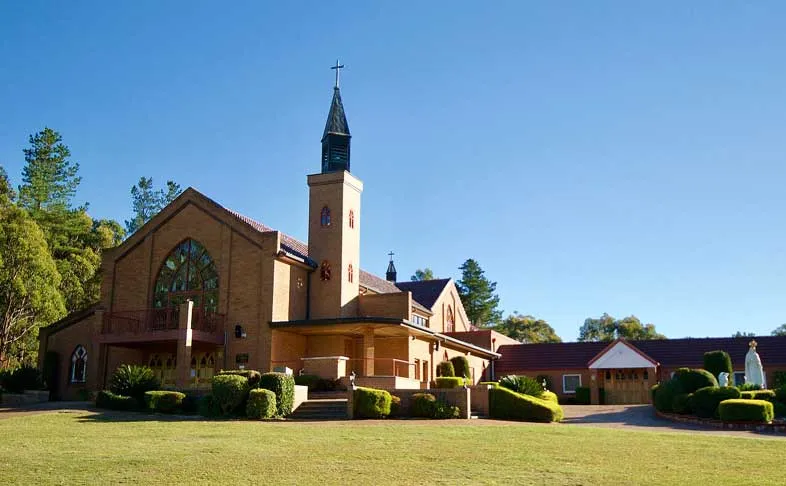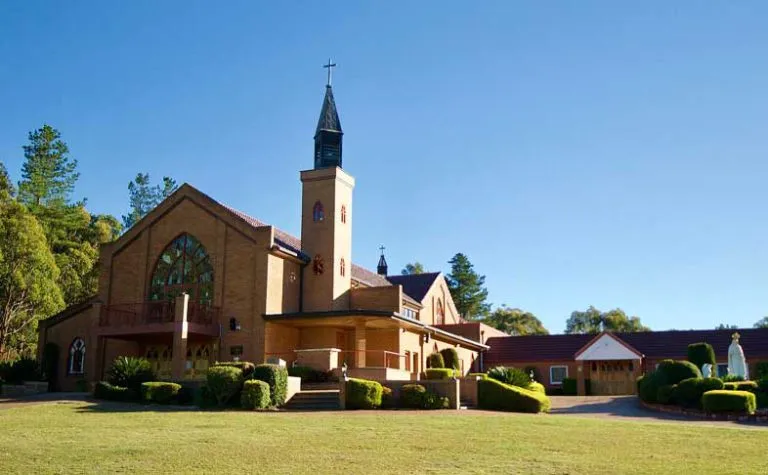
Introduction
The Shrine of Our Lady of Mercy, commonly known as Penrose Park (located in the Southern Highlands, NSW), Sutton Forest, Australia is a Catholic place of veneration of the replica of the Our Lady of Jasna Góra, a Black Madonna. The shrine is ministered by the Order of Saint Paul the First Hermit, known as the Pauline Fathers, who have been the custodians of the original Icon of the Black Madonna since 1382. The Shrine of Our Lady of Mercy, Penrose Park, is one of only two shrines dedicated to Our Lady in Australia.
When Fr. Augustine Lazur OSPPE first set foot in Australia in April 1981, he was given the mission to spread the honour of Our Lady of Jasna Gora to yet another country. After many fascinating adventures, Father was led to the Southern Highlands of New South Wales and, in 1984, with a great deal of faith, and the help of many benefactors, purchased the property now known as Penrose Park.
It is a story that stirs the imagination, but those early days of the Order in Australia saw many miracles of faith. Miracles that have continued through to the present day. Just ten years after Father Augustine arrived in Australia, the Pauline Fathers first moved into the newly-built Monastery, and in 1995 a start was made upon further extensions, the Pauline Fathers moving into their improved quarters and their lovely private chapel during that year.
Thanks to the tremendous response of the pilgrims who came here in large numbers, especially for the Fatima Day celebrations on the 13th day of each month, work progressed on the beautiful new church from mid-1994 until the present, when we can see the fulfilment of all our dreams.
May 24th 1997, was a great day of celebration. With the consecration of the new church and monastery, work continued to make the Church and the grounds of Penrose Park even more beautiful. With the blessing of Our Lady of Mercy, as She is known in Australia and the support of thousands of faithful pilgrims, we have already witnessed many miracles here. Following the Consecration of the Church, due to the popularity of the Shrine, special events have been held here.
One of the most important events was on 25 June 2000, the Feast of Corpus Christi, the Final Celebration of the Diocese of Wollongong’s Eucharistic Congress, which culminated in a Solemn Mass and Procession. The principal celebrant was His Excellency Archbishop Francesco Canalini DD, Apostolic Nuncio to Australia, who was joined by Most Rev. Philip Wilson DD JCL, Bishop of Wollongong; Most Rev. Barry J Hickey DD OAM, Archbishop of Perth; the Community of the Pauline Fathers and other visiting Bishops and Clergy.
History of Shrine of Our Lady of Mercy, Penrose Park
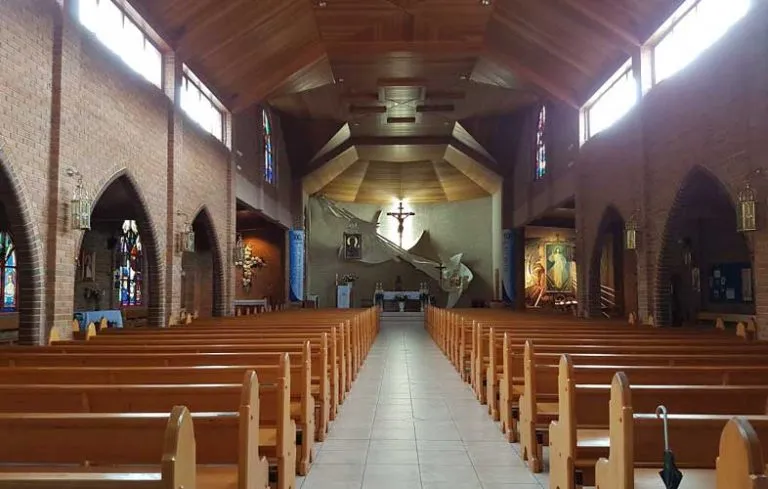
The Icon was crowned in 2001 with crowns also blessed by the pope for the occasion. The tradition of crowning an Icon began in Rome as a way of acknowledgement of the powerful intercession of Our Lady for all pilgrims. Why we crown Our Lady of Mercy: Holy Mother, the Church has on many occasions asserted that it is lawful to venerate images of Christ, his Mother, and the saints and has often instructed the faithful on the proper understanding of such veneration.
In the East and West, the practice of depicting the Blessed Virgin Mary wearing a regal crown came into use in the era of the Council of Ephesus (A.D. 431). Since then, Christian artists have often portrayed the glorified Mother of the Lord seated on a throne, dressed in royal robes, and surrounded by a court of angels and saints. In many such images, Christ is shown placing a crown on his Mother’s head.
It is especially from the end of the 16th century that the practice became widespread in the West for the faithful, both religious and laity, to crown images of the Blessed Virgin. The popes not only endorsed this devout custom but “on many occasions, either personally or through bishop-delegates, carried out the coronation of Marian images.” As the Order of Crowning states,” it should be noted that it is proper to crown only those images to which the faithful come with a confidence in the Mother of the Lord so strong that the images are of great renown and their sites centres of genuine liturgical cults and religious vitality”.
Approx. Seventy thousand pilgrims visit our Shrine annually, and in keeping with the tradition of the Church and the generosity of the pilgrims, we were able to crown our Icon. This was the first time a Holy Image was crowned in Australia. Saint Pope John Paul II blessed the crowns in Rome on 23 May 2001.
The coronation ceremony took place in the Shrine Church on 26 August 2001 during the Solemn Mass, with the main celebrant being His Excellency Archbishop Francesco Canalini DD, with the assistance of His Lordship Peter Ingham, DD Bishop of Wollongong. Also present were Most Rev Bishop William Murray and representatives of the Federal, State and Foreign governments, as well as other priests and religious.
In 2008 the shrine welcomed the Youth of the World as part of World Youth Day 2008. The young people came in their hundreds from America, Germany, Italy, Spain, South America, France, England, etc. In 2010 the shrine decided to purchase the property adjacent to the Shrine. The property consists of 2 houses situated on approx. 50 acres of land. This has enabled us to move our Religious Shop into one of the houses and increase its stock. It has also provided a temporary retreat accommodation for very small groups.
In 2011 the shrine began renovation of the building known as the Old Monastery, which was the place of residence for the first priests before the construction of the Church and Monastery as is today. The renovations should be completed by the end of 2011. The building will be a reminder of the life of the first Pauline Monks in Australia, and the Chapel will be able to be used by small groups of pilgrims for special occasions.
Saint Paul the First Hermit
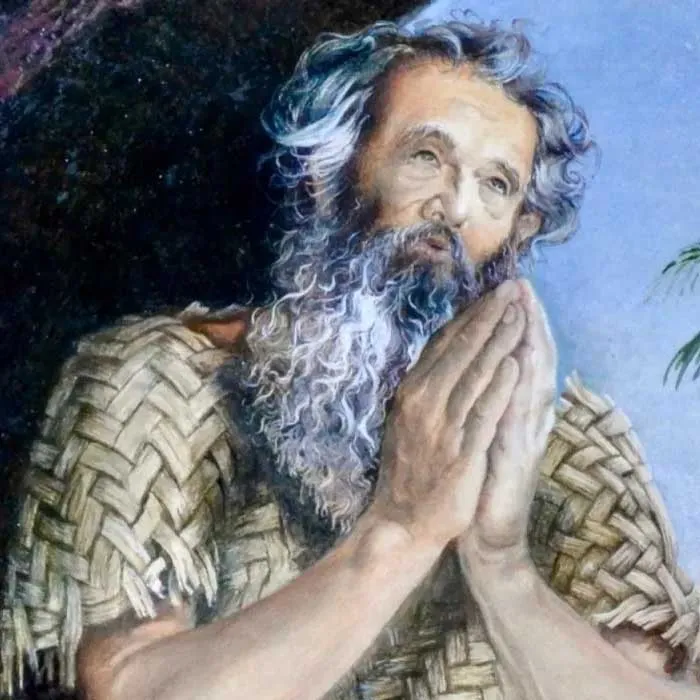
St Paul the Hermit should not be confused with St Paul the Apostle. St Paul the Hermit is traditionally considered the first saint living a solitary life. He was born around 228 to wealthy and noble parents in Alexandria, Egypt.
During the persecution of the Christians by Caesar Decius in 250, young Paul fled to the Desert in Thebes by the Red Sea and learned to enjoy his solitary life “alone with God alone,” so much that he remained there for the rest of his life. He lived nearly ninety years in prayerful solitude, constant penance, and contemplation of God. Then, before he died, he was discovered by St Anthony the Abbot, who spread the news about his holiness.
It is believed that St Paul was kept alive by the fruit of a palm tree and by a raven which brought him a piece of bread daily. He died at the age of 113, when, as related by St Anthony, two lions dug a grave for him. This story is captured in the coat-of-arms of the Order, showing the palm tree, two lions and a raven. The Pauline Order chose St. Paul the First Hermit as its Patron and Patriarch and thus took the name “Order of St. Paul the First Hermit”.
The Order solemnly observes the feast of St. Paul on January 15th. In a spirit of appreciation, the Pauline Fathers offer yearly a novena of prayers in honour of St. Paul the Hermit for all their benefactors, friends and supporters.
Our Lady of Czestochowa Queen of Poland

The Shrine holds a replica of the Icon of the Black Madonna, which was blessed by Pope John Paul II in 1984 and then crowned in 2001 with crowns also blessed by the pope for the occasion. But what is the history of the original Icon?
The history of Christianity in Poland begins in the year 966 when Mieszko the First accepted Baptism, and the Polish people followed the example of their ruler. In the course of the thousand years that have followed, devotion to Mary the Mother of God has had a central part in the life of the people.
For almost six hundred of those years, this Marian devotion has been centred around the Shrine of Our Lady of Czestochowa, where the famous Icon of Our Lady has its home. The Shrine looks down on the present-day industrial city of Czestochowa, a city of some one hundred and sixty thousand persons, on the Warta River in South Central Poland, from a hill called Jasna Gora, the Mountain of Light, named after the white rock that forms it.
It is here that Mary is honoured today. She is honoured by more than a million pilgrims who visit the Shrine annually, and she is honoured by Polish people worldwide. They honour her as the Queen of Poland, and their continual presence at the Shrine in such large numbers has made Jasna Gora the most frequented Marian shrine for pilgrimages in central Europe.
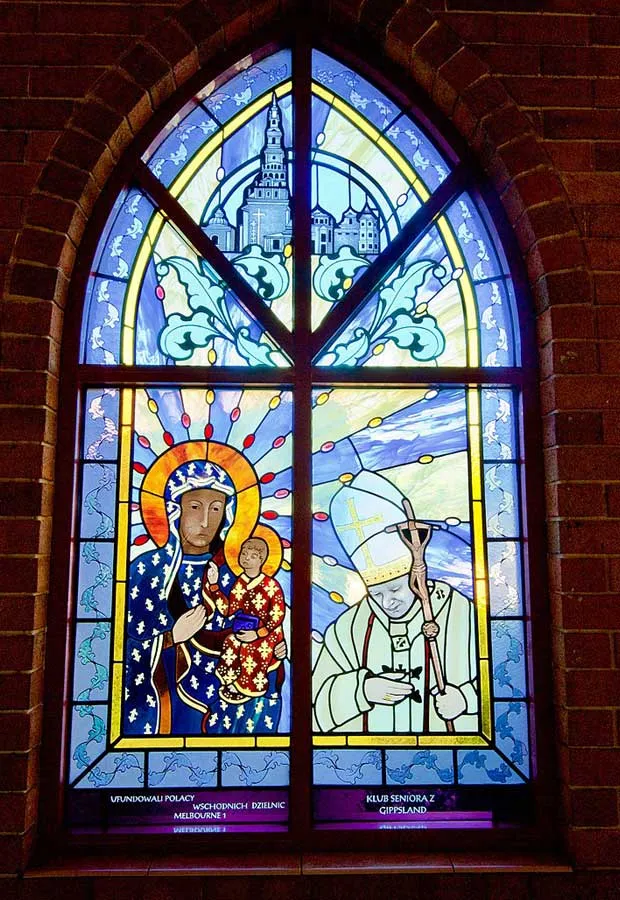
The Icon
The famous Icon of Our Lady came to Jasna Gora in 1382 after Ladislaus, Duke of Opole, had acquired it in Red Ruthenia, modern-day Western Ukraine, where he had seen it at the castle of Belz. What was the Icon’s origin before that is shrouded in mystery and speculation. Still, when the Prince took a liking to the Icon and wished to take it with him, it was already treated with great reverence and honoured as a priceless relic.
According to legend, the Icon was painted by St. Luke and brought from Jerusalem to Constantinople before going to Ruthenia. Research, however, suggests that the Icon is more probably of ninth-century Greek or Italian origin with thirteenth-century over paintings and is painted with some sort of colours and pigments on a wooden base. It is in the Byzantine tradition after the style of icons attributed to St. Luke and has since been richly ornamented in gold and jewels of great value. The Icon, which is generally covered with these ornaments, is darkened by smoke on the exposed parts of the face and hands and often receives the title of the Black Madonna.
The duke left the Icon at Jasna Gora in 1384 under the protection of the Pauline Fathers, whom he had brought there from Hungary. It was placed in the small wooden church already on the mountain, but so great was the flow of pilgrims to visit it that within thirty years, the church became too small, and the monastic Order of Pauline Fathers, who usually made little contact with the world was forced to adapt their own lifestyle.
Not long after the Icon was brought to Jasna Góra, it was sacrilegiously attacked and damaged during Holy Week of 1430 when thieves seized it from above the high altar and slashed it with swords. This act by foreign invaders saddened and shocked the people and was seen as an act of religious hatred as well as an attempt to stir up political trouble.
The Icon was taken to Krakow, where it was carefully restored and repaired, but the marks left by the sword slashes could not be removed entirely, and they can still be seen on the right cheek of the Madonna. The Icon was returned to its Shrine, and at once, veneration increased rapidly. It declined around the time of the Reformation in the sixteenth century, but when the Counter Reformation later in that century emphasized the devotion to Our Lady, Jasna Gora returned it to its original splendour.
Fatima Day
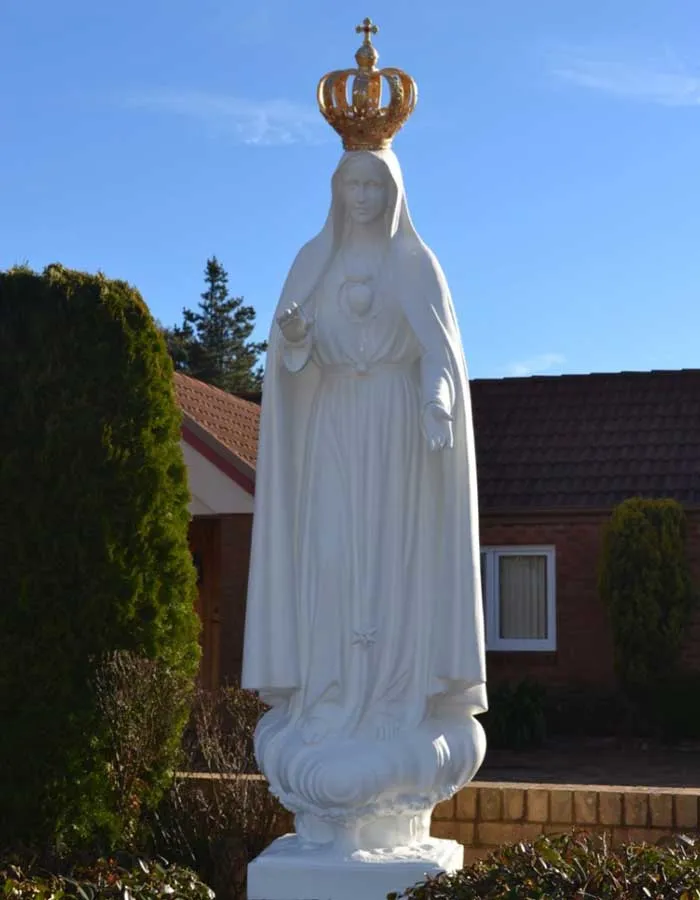
Our Lady of Fatima is just one of the many names given to the Blessed Virgin Mary. On the 13th day of each month, a pilgrimage takes place at Penrose Park to the Shrine of Our Lady of Mercy, traditionally celebrated in the month of May.
The Shrine
Shortly after the Icon’s restoration following the sacrilegious attack, construction of a vast new church began. This, in turn, was rebuilt as a basilica following heavy damage by fire in 1690. The chapel containing the Icon was enlarged in 1644 and remains like that today. Finally, at the beginning of the eighteenth century, a tower of one hundred and five metres was built onto the church, which now dominates the city skyline in Czestochowa. A monastery completes the site.
The holy Icon was crowned in the name of Pope Clement XI in 1717, and after the theft of the crowns in 1909, it received new crowns sent by Pope St. Pius X the following year. To mark the one-hundredth anniversary of this event, the Icon was crowned with a new set of crowns blessed by Pope Benedict XVI on March 3rd 2010.
Miraculous Interventions in History
The Icon is regarded as miraculous because of the many miracles attributed to prayers offered before it. Some of these have been associated with the victories in wars that have swept through Poland.
In 1655 when Swedish invaders moved through Poland, taking all in their path, they met their first defeat at Jasna Gora when they could not take possession of the mountain and its buildings and were forced to retreat.
In 1683 the defeat of the Turkish armies at Vienna saved Christianity in Europe. Their defeat was due to the intervention of the Polish military, whose King went into battle in the name of Our Lady of Czestochowa, at whose Shrine he prayed before setting out on his mission.
In 1920 Bolshevik invaders moved to Warsaw to take the whole country. However, while the enemy was in sight of its target, the people of Poland prayed fervently to their Queen and Mother, and on August 15th, the Feast of the Assumption, the enemy retreated.
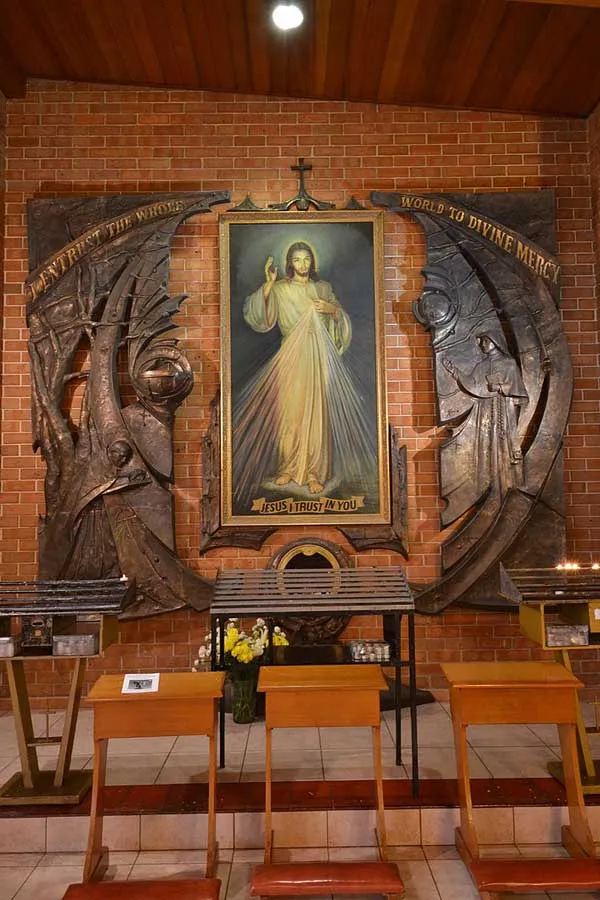
Queen of Poland
Following the victory of 1655, Jan Casimir made a vow in the Cathedral of Lvov, putting his country under Our Lady’s protection and declaring her to be Queen of Poland.
“I, Jan Casimir, King of Poland, take thee as Queen and Patroness of my kingdom; I put my people and my army under thy protection”. This vow made by the king was accepted and ratified by both houses of parliament.
And so it is today that in all Polish churches and homes of Polish people scattered throughout the world, an Icon of Our Lady of Czestochowa is to be found, and Our Lady is honoured as truly the Queen of the country and its people. She is Queen by vow, by an act of parliament and by honour.
For this reason, each parish in Poland gathers in strength once a year for a series of devotions in honour of Our Lady, and the various Dioceses make annual pilgrimages to the Shrine so that the people as a group can honour their Queen and Protectress.
Effects of the Devotion
One of the most significant effects of the devotion is the keeping together and unity of the nation. Whenever the country has been divided and partitioned, whenever it has changed from administration by one government to that of another, the Shrine of Our Lady at Jasna Gora has remained as a united and uniting place of devotion and a centre where people can come, crossing the frontiers made by man. As often as governments and armies have tried to divide the people, Jasna Gora has brought them together.
Another effect of the Shrine has been the gathering together and custody of much of the nation’s art treasures. The kings and princes who honoured the Shrine in its early years came bearing gifts; pilgrims, too, in their own way, have done likewise; artists’ skills are reflected in the decoration of the Shrine and its surroundings.
The result is that Jasna Gora is not only a pilgrimage destination but also the custodian and protector of much of the country’s national heritage of art. It is indeed fortunate that two recent world wars, the Nazi occupation and, more recently, a Communist government, have left the Shrine and its treasures unscathed, thereby preserving this reminder of the skills and talents of the Polish people.
The Shrine Today
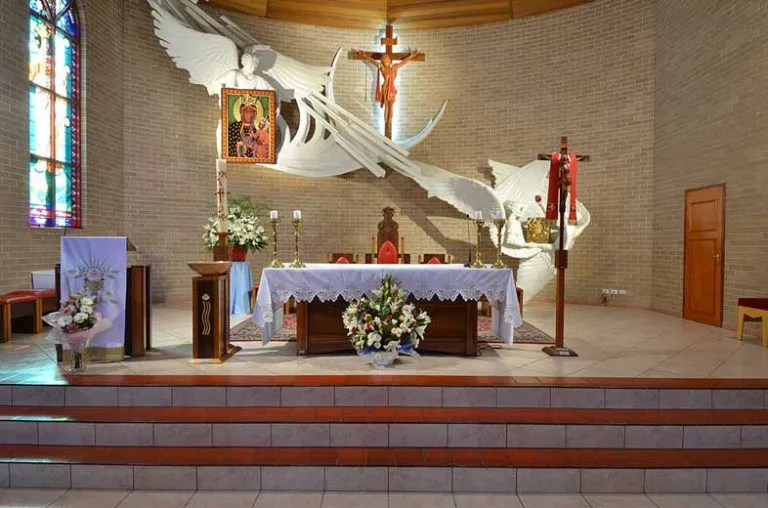
The Shrine of Our Lady on Mount Jasna Gora demonstrates how devotion to Our Lady is part of the life of the Polish people. The Shrine houses the miraculous Icon before which the people pray. In their devotion to the Mother of God, they acknowledge their dependence on God and his place in their lives. In their prayers, they acknowledge Mary as their Mother and protector and the one who can most readily bring them to her Son. The con’s miraculous nature is found in God’s response to these prayers.
The invaders of Poland have long been aware that the strength of the Polish people lies in their faith expressed in their devotion to their Queen. As long as the hill of Jasna Gora at Czestochowa remains a pilgrimage shrine with the same large numbers of people coming to pray, that strength will remain.
Feast Day – 26th August
The Church honours the Blessed Virgin Mary under the patronage of Our Lady of Częstochowa.
Annual Feast Day of the Shrine of Our Lady of Mercy, Penrose Park held on 26th August.
The Black Madonna of Częstochowa is a revered icon of the Virgin Mary housed at the Pauline Monastery of Jasna Góra in the city of Częstochowa, in Poland.
Mass Time
Weekdays
Sundays
Last Sunday of Each Month
Church Visiting Time
Contact Info
120, Hanging Rock Road,
Sutton Forest, NSW 2577, Australia.
Phone No.
Tel : +61 2 4878 9192
Accommodations
How to reach the Shrine
Nowra Airport in Nowra Hill, Australia is the nearby Airport to the Shrine.
Penrose Train Station in Penrose, Australia is the nearby Train Station to the Shrine.

